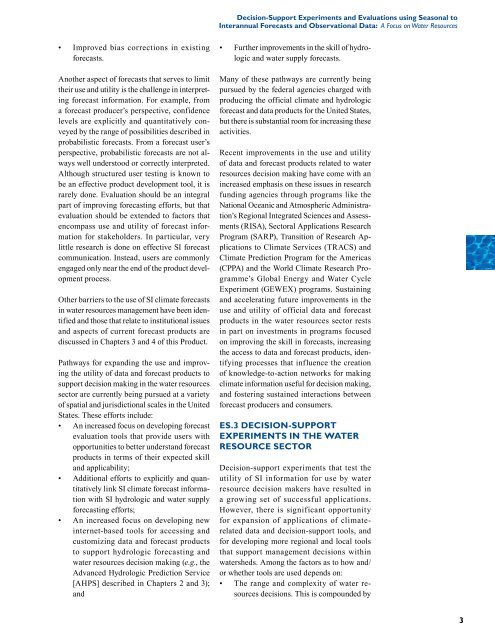Decision support experiments and evaluations using seasonal to ...
Decision support experiments and evaluations using seasonal to ...
Decision support experiments and evaluations using seasonal to ...
Create successful ePaper yourself
Turn your PDF publications into a flip-book with our unique Google optimized e-Paper software.
•<br />
Improved bias corrections in existing<br />
forecasts.<br />
Another aspect of forecasts that serves <strong>to</strong> limit<br />
their use <strong>and</strong> utility is the challenge in interpreting<br />
forecast information. For example, from<br />
a forecast producer’s perspective, confidence<br />
levels are explicitly <strong>and</strong> quantitatively conveyed<br />
by the range of possibilities described in<br />
probabilistic forecasts. From a forecast user’s<br />
perspective, probabilistic forecasts are not always<br />
well unders<strong>to</strong>od or correctly interpreted.<br />
Although structured user testing is known <strong>to</strong><br />
be an effective product development <strong>to</strong>ol, it is<br />
rarely done. Evaluation should be an integral<br />
part of improving forecasting efforts, but that<br />
evaluation should be extended <strong>to</strong> fac<strong>to</strong>rs that<br />
encompass use <strong>and</strong> utility of forecast information<br />
for stakeholders. In particular, very<br />
little research is done on effective SI forecast<br />
communication. Instead, users are commonly<br />
engaged only near the end of the product development<br />
process.<br />
Other barriers <strong>to</strong> the use of SI climate forecasts<br />
in water resources management have been identified<br />
<strong>and</strong> those that relate <strong>to</strong> institutional issues<br />
<strong>and</strong> aspects of current forecast products are<br />
discussed in Chapters 3 <strong>and</strong> 4 of this Product.<br />
Pathways for exp<strong>and</strong>ing the use <strong>and</strong> improving<br />
the utility of data <strong>and</strong> forecast products <strong>to</strong><br />
<strong>support</strong> decision making in the water resources<br />
sec<strong>to</strong>r are currently being pursued at a variety<br />
of spatial <strong>and</strong> jurisdictional scales in the United<br />
States. These efforts include:<br />
• An increased focus on developing forecast<br />
evaluation <strong>to</strong>ols that provide users with<br />
opportunities <strong>to</strong> better underst<strong>and</strong> forecast<br />
products in terms of their expected skill<br />
<strong>and</strong> applicability;<br />
• Additional efforts <strong>to</strong> explicitly <strong>and</strong> quantitatively<br />
link SI climate forecast information<br />
with SI hydrologic <strong>and</strong> water supply<br />
forecasting efforts;<br />
• An increased focus on developing new<br />
internet-based <strong>to</strong>ols for accessing <strong>and</strong><br />
cus<strong>to</strong>mizing data <strong>and</strong> forecast products<br />
<strong>to</strong> <strong>support</strong> hydrologic forecasting <strong>and</strong><br />
water resources decision making (e.g., the<br />
Advanced Hydrologic Prediction Service<br />
[AHPS] described in Chapters 2 <strong>and</strong> 3);<br />
<strong>and</strong><br />
<strong>Decision</strong>-Support Experiments <strong>and</strong> Evaluations <strong>using</strong> Seasonal <strong>to</strong><br />
Interannual Forecasts <strong>and</strong> Observational Data: A Focus on Water Resources<br />
•<br />
Further improvements in the skill of hydrologic<br />
<strong>and</strong> water supply forecasts.<br />
Many of these pathways are currently being<br />
pursued by the federal agencies charged with<br />
producing the official climate <strong>and</strong> hydrologic<br />
forecast <strong>and</strong> data products for the United States,<br />
but there is substantial room for increasing these<br />
activities.<br />
Recent improvements in the use <strong>and</strong> utility<br />
of data <strong>and</strong> forecast products related <strong>to</strong> water<br />
resources decision making have come with an<br />
increased emphasis on these issues in research<br />
funding agencies through programs like the<br />
National Oceanic <strong>and</strong> Atmospheric Administration’s<br />
Regional Integrated Sciences <strong>and</strong> Assessments<br />
(RISA), Sec<strong>to</strong>ral Applications Research<br />
Program (SARP), Transition of Research Applications<br />
<strong>to</strong> Climate Services (TRACS) <strong>and</strong><br />
Climate Prediction Program for the Americas<br />
(CPPA) <strong>and</strong> the World Climate Research Programme’s<br />
Global Energy <strong>and</strong> Water Cycle<br />
Experiment (GEWEX) programs. Sustaining<br />
<strong>and</strong> accelerating future improvements in the<br />
use <strong>and</strong> utility of official data <strong>and</strong> forecast<br />
products in the water resources sec<strong>to</strong>r rests<br />
in part on investments in programs focused<br />
on improving the skill in forecasts, increasing<br />
the access <strong>to</strong> data <strong>and</strong> forecast products, identifying<br />
processes that influence the creation<br />
of knowledge-<strong>to</strong>-action networks for making<br />
climate information useful for decision making,<br />
<strong>and</strong> fostering sustained interactions between<br />
forecast producers <strong>and</strong> consumers.<br />
ES.3 DECISION-SUPPORT<br />
EXPERIMENTS IN THE WATER<br />
RESOURCE SECTOR<br />
<strong>Decision</strong>-<strong>support</strong> <strong>experiments</strong> that test the<br />
utility of SI information for use by water<br />
resource decision makers have resulted in<br />
a growing set of successful applications.<br />
However, there is significant opportunity<br />
for expansion of applications of climaterelated<br />
data <strong>and</strong> decision-<strong>support</strong> <strong>to</strong>ols, <strong>and</strong><br />
for developing more regional <strong>and</strong> local <strong>to</strong>ols<br />
that <strong>support</strong> management decisions within<br />
watersheds. Among the fac<strong>to</strong>rs as <strong>to</strong> how <strong>and</strong>/<br />
or whether <strong>to</strong>ols are used depends on:<br />
• The range <strong>and</strong> complexity of water resources<br />
decisions. This is compounded by<br />
3




